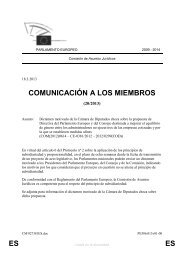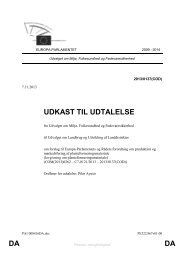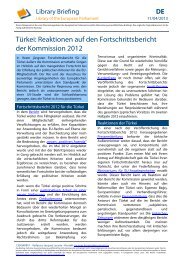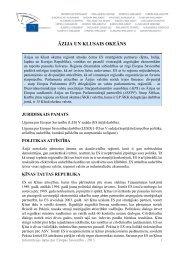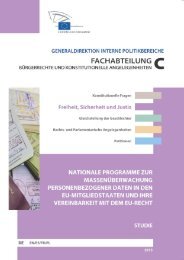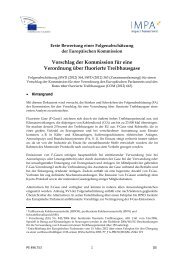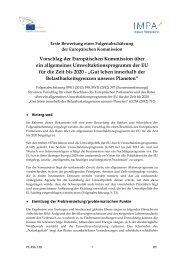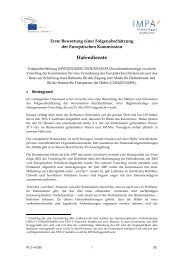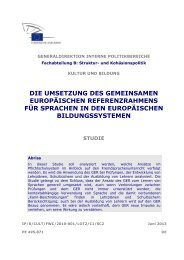Link to the study - European Parliament - Europa
Link to the study - European Parliament - Europa
Link to the study - European Parliament - Europa
Create successful ePaper yourself
Turn your PDF publications into a flip-book with our unique Google optimized e-Paper software.
Policy Department D: Budgetary Affairs<br />
____________________________________________________________________________________________<br />
Slovakia<br />
As of <strong>the</strong> end of 2008, al<strong>to</strong>ge<strong>the</strong>r 1 242 people were employed at JAVYS, of which <strong>the</strong> V1 NPP<br />
division had 382 employees. The amount of <strong>the</strong> employees was reduced in several steps of changing<br />
<strong>the</strong> organisational structure of JAVYS according <strong>to</strong> <strong>the</strong> pre-decommissioning and <strong>the</strong> 1 st<br />
decommissioning stage (as defined in <strong>the</strong> license requirements). In January 2012, JAVYS had 897<br />
employees; 382 people of <strong>the</strong>m were employed at <strong>the</strong> V1 Decommissioning Division and <strong>the</strong> Project<br />
Management Unit division (CPD 2012).<br />
After 2006, an intensive communication with and training programs for those, who were previously<br />
operational personnel, was required in order <strong>to</strong> achieve a general acceptance of <strong>the</strong> new profession.<br />
JAVYS also hired external workforce for several activities in reasonable cases and where an economic<br />
benefit for <strong>the</strong> company was expected (ANNEX 5).<br />
4.8.2. Comparison and evaluation of workforce aspects<br />
In accordance with <strong>the</strong> best practices identified at EDF and EWN all three countries have ei<strong>the</strong>r<br />
directly (Lithuania) or indirectly, via a change in <strong>the</strong> managing institution (Bulgaria, Slovakia), decided<br />
<strong>to</strong> use knowledge and skills of existing personnel in <strong>the</strong> NPPs. While <strong>the</strong> change at EWN <strong>to</strong>ok only<br />
short time, it <strong>to</strong>ok a longer phase in <strong>the</strong> similar Lithuanian case <strong>to</strong> establish new structures and a<br />
different understanding. This points <strong>to</strong> a possible previous underestimation that <strong>the</strong> conversion will<br />
in any way be necessary and unavoidable by <strong>the</strong> previous management, or <strong>to</strong> an unwillingness <strong>to</strong><br />
change <strong>the</strong> approach as rapidly as necessary.<br />
Bulgaria and Slovakia, which <strong>to</strong>ok a more indirect way of installing new substructures in <strong>the</strong>ir<br />
managing organisations, are more comparable <strong>to</strong> EDFs approach (establishing CIDEN as managing<br />
organisation, see chapter 3.2.2). In <strong>the</strong>se cases <strong>the</strong> conversion ran faster and in a more strict form, but<br />
was associated with a higher risk for fundamental frictions and failures (Bulgaria).<br />
4.8.3. Recommendations<br />
The relevance of workforce issues, such as conversion management and training, is well recognized in<br />
all three countries. Explicit training, e.g. in <strong>the</strong> less technical and more soft skill areas of project<br />
management, risk communication and knowledge management is recommendable.<br />
4.9. EXAMPLE OF DISTRIBUTED RESPONSIBILITY: THE PLASMA OVEN AT KOZLODUY<br />
NUCLEAR POWER PLANT<br />
In order <strong>to</strong> understand decision distribution and its weaknesses better, <strong>the</strong> plasma oven facility at<br />
Kozloduy NPP is selected as an example. It shows how difficult it is <strong>to</strong> identify responsible persons<br />
and organisations for a certain decision in a distributed responsibility environment.<br />
4.9.1. First failure <strong>to</strong> identify responsible decision makers<br />
The <strong>European</strong> Court of Audi<strong>to</strong>rs described this example as follows:<br />
'In Bulgaria, an experimental plasma melting technology was selected in Kozloduy without proper<br />
demonstration of its effectiveness and without due consideration of <strong>the</strong> design and construction<br />
costs (some 30 million euro compared <strong>to</strong> one fifth for traditional technologies).' (ECoA 2011)<br />
124




